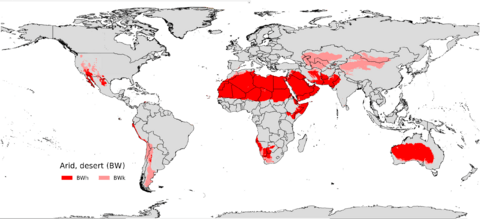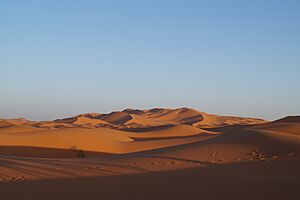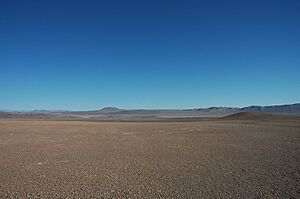Desert climate facts for kids
Desert climate or Arid climate (in the Köppen climate classification: BWh "hot desert climate" and BWk "cold desert climate") is a type of climate where precipitation is generally less than 250 millimetres (10 in) a year. Low rainfall is a feature of deserts such as the Arabian, central Australia and the Sahara. It is a feature of continental interiors, the western sides of continents, and the leeward side of tall mountain ranges. Parts of the Arctic and Antarctic have arid climates even though they are cold.
Contents
Defining a desert
A "true desert" is one where plant cover is very sparse and rainfall is rare or infrequent. Because desert air is dry there is little moisture to hold onto the heat of the day. Desert nights are usually very cold. This wide temperature variation can make a desert climate difficult to live in.
Some deserts get more than 250mm of rainfall yearly but are still arid areas. For example, the Kalahari Desert gets up to 640 millimetres (25 in) a year. It has great sand dunes like the Sahara, but they do not shift in the winds. They have plants that anchor the sand and help to keep their shape. Other areas can also have more than 250mm of precipitation but lose more water via evapotranspiration than falls as precipitation. Tuscon and Alice Springs are good examples of this. Tucson gets an average of 303 millimetres (12 in) of rainfall a year. Alice Springs receives about 540 millimetres (21 in) yearly. Some scientists do not consider these as true deserts.
Types
There are three types of desert climates in the Köppen climate classification: a hot desert climate (BWh), a cold desert climate (BWk) and a mild desert climate (BWh/BWn). Hot deserts have very hot summers that have temperatures that can even reach 45 °C (113 °F). Temperatures can even be very warm during winter. Cold deserts can have hot summers as well, but the winters are usually very cold. They are usually at high altitudes and can be drier than hot deserts.
Hot desert climates
Hot desert climates (BWh) are typically found under the subtropical ridge in the lower middle latitudes or the subtropics, often between 20° and 33° north and south latitudes. In these locations, stable descending air and high pressure aloft clear clouds and create hot, arid conditions with intense sunshine. Hot desert climates are found across vast areas of North Africa, Western Asia, northwestern parts of the Indian Subcontinent, southwestern Africa, interior Australia, the Southwestern United States, the south-eastern coast of Spain, northern Mexico, the coast of Peru, and Chile. This makes hot deserts present in every continent except Antarctica.
At the time of high sun (summer), scorching, desiccating heat prevails. Hot-month average temperatures are normally between 29 and 35 °C (84 and 95 °F), and midday readings of 43–46 °C (109–115 °F) are common. The world absolute heat records, over 50 °C (122 °F), are generally in the hot deserts, where the heat potential can be the highest on the planet. This includes the record of 56.7 °C (134.1 °F) in Death Valley, which is currently considered the highest temperature recorded on Earth. Some deserts in the tropics consistently experience very high temperatures all year long, even during wintertime. These locations feature some of the highest annual average temperatures recorded on Earth, exceeding 30 °C (86 °F), up to nearly 35 °C (95 °F) in Dallol, Ethiopia. This last feature is seen in sections of Africa and Arabia. During colder periods of the year, night-time temperatures can drop to freezing or below due to the exceptional radiation loss under the clear skies. However, very rarely do temperatures drop far below freezing under the hot subtype.
Hot desert climates can be found in the deserts of North Africa such as the wide Sahara Desert, the Libyan Desert or the Nubian Desert; deserts of the Horn of Africa such as the Danakil Desert or the Grand Bara Desert; deserts of Southern Africa such as the Namib Desert or the Kalahari Desert; deserts of Western Asia such as the Arabian Desert, or the Syrian Desert; deserts of South Asia such as Dasht-e Lut and Dasht-e Kavir of Iran or the Thar Desert of India and Pakistan; deserts of the United States and Mexico such as the Mojave Desert, the Sonoran Desert or the Chihuahuan Desert; deserts of Australia such as the Simpson Desert or the Great Victoria Desert and many other regions. In Europe, the hot desert climate can be found only on the southeastern coast of Spain.
Hot deserts are lands of extremes: most of them are among the hottest, the driest and the sunniest places on Earth because of nearly constant high pressure; the nearly permanent removal of low-pressure systems, dynamic fronts and atmospheric disturbances; sinking air motion; dry atmosphere near the surface and aloft; the exacerbated exposure to the sun where solar angles are always high makes this desert inhospitable to most species.
Cold desert climates
Cold desert climates (BWk) usually feature hot (or warm in a few instances), dry summers, though summers are not typically as hot as hot desert climates. Unlike hot desert climates, cold desert climates tend to feature cold, dry winters. Snow tends to be rare in regions with this climate. The Gobi Desert in northern China and Mongolia is one example of cold desert. Though hot in the summer, it shares the very cold winters of the rest of Inner Asia. Summers in South America's Atacama Desert are mild with only slight temperature variations between seasons. Cold desert climates are typically found at higher altitudes than hot desert climates and are usually drier than hot desert climates.
Cold desert climates are typically located in temperate zones, usually in the leeward rain shadow of high mountains, which restricts precipitation from the westerly winds. An example of this is the Patagonian Desert in Argentina bounded by the Andes ranges to its west. In the case of Central Asia, mountains restrict precipitation from the eastern monsoon. The Kyzyl Kum, Taklamakan and Katpana Desert deserts of Central Asia are other major examples of BWk climates. The Ladakh region, and the city of Leh in the Great Himalayas in India also have a cold desert climate. In North America, the cold desert climate occurs in the drier parts of the Great Basin Desert and the Bighorn Basin in Big Horn and Washakie County in Wyoming. The Hautes Plaines, located in the northeastern section of Morocco and in Algeria is another major example of a cold desert climate. In Europe, this climate can only be found in some inland parts of southeastern Spain, such as in Lorca.
Arctic and Antarctic regions also receive very little precipitation during the year, owing to the exceptionally cold dry air freezing most precipitation; however, both of them are generally classified as having polar climates because they have average summer temperatures below 10 °C (50 °F) even if they have such desert-like features as intermittent streams, hypersaline lakes, and extremely barren terrain in unglaciated areas such as the McMurdo Dry Valleys of Antarctica.
Adaptations
Desert plants and animals have adapted to living in desert climates. Some animals can get by on less water. Some plants are able to store water. Some animals, like snakes, lizards and scorpions use poisonous venoms to kill for food. This saves valuable energy: they do not need to chase, fight or catch their prey. Many animals are nocturnal. They sleep in cool caves or burrows during the day and hunt at night. Plants likewise have adapted to saving water. Some have waterproof coverings that prevent the plant or seeds from drying out. Some, like the giant Saguaro cactus, store water. They have adapted so well that they can live for more than 150 years and can average over 40 ft tall. Many types have thorns and protective spines that keep animals from getting at their stores of water.
Related pages
See also
 In Spanish: Clima árido para niños
In Spanish: Clima árido para niños






